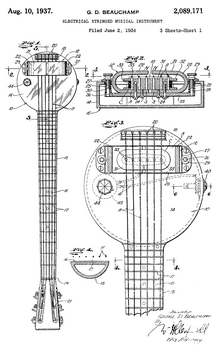Electro-Spanish Model B
This article needs additional citations for verification. (May 2018) |
| Rickenbacher Electro-Spanish Model B | |
|---|---|
| Manufacturer | Rickenbacker |
| Construction | |
| Body type | Solid-Body, |
| Neck joint | Bolt on |
| Scale | 22.5" |
| Woods | |
| Body | Bakelite |
| Neck | Bakelite |
| Fretboard | Bakelite with pearl or paint dot inlay |
| Hardware | |
| Bridge | Vib-rol-a patented by Clayton Doc Kauffman
 |
| Pickup(s) | Horseshoe pickup
 |
| Colors available | |
| black/brown | |
The Electro-Spanish Model B was the world's first production, solid body (Bakelite) electrified guitar, officially released in 1935 by Rickenbacker, and based on the 1931 "Model B Hawaiian" Lap Steels. Unlike the Square-necked lap steel models, the "Electro-Spanish" model had a round neck and was meant to be played as a conventional guitar. Commercially, it was the most successful musical instrument manufactured by Rickenbacker. Though not entirely solid - it had thick plastic (Bakelite) walls and a detachable Spanish neck. The instrument was created to eliminate the feedback found in conventional electrification of stringed instruments.[1]
The Electro-Spanish Model B set the stage for
solid body guitars to develop; including the Fender Esquire in 1950 and the Gibson Les Paul
in 1952.
References
- ^ Rickenbacker, Rickenbacker. "Early History". Rickenbacker. Staff. Archived from the original on 24 December 2005. Retrieved 18 August 2016.
